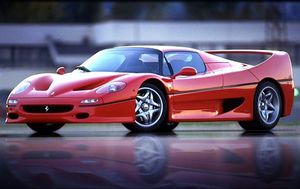.
Ferrari F50
| Ferrari F50 | |
|---|---|

| |
| Manufacturer | Ferrari |
| Production | 1995-1999 |
| Class | Supercar |
| Body style | Berlinetta |
| Lengh | 176 in |
| Width | 78 in |
| Height | 44 in |
| Weight | 2710 lb |
| Transmission | 6-speed manual |
| Engine | 4.7 L V-12 |
| Similar | |
The Ferrari F50 was the successor to the Ferrari F40, the car created to commemorate Ferrari's 50th anniversary and the last car built while Enzo Ferrari was still alive.
The F50 was the first car to follow formula one specs of its generation including how the suspension components were incorporated with the engine.
The springs, which on all other cars are mounted vertically, were mounted horizontally and the engine supported the entire suspension unit and in return, the suspension unit is what supported the engine. That is to say, that if the engine was for what ever reason removed from the car, the suspension would essentially fall apart. Exactly the same as with any F1 car of the day.
The F50 also mirrored F1 cars in that it was a lower torque engine with extremely high horsepower with a redline at nearly 10000 rpm.
As a result of these ideas, the F50 was not just a bunch of individual compenents assembled in a model T kind of way, rather, the F50 was an orchestra of components that need each other in order to be effective. This is not unlike how our human bodies work and certainly the model in which all Formula One race cars follow.
Today, the F50 continues to inspire many. Websites such as www.f50.com have been created in honor of the great car and marquee and the f50 was the car that set the path for the Ferrari Enzo, Ferrari's latest supercar. 202mph
